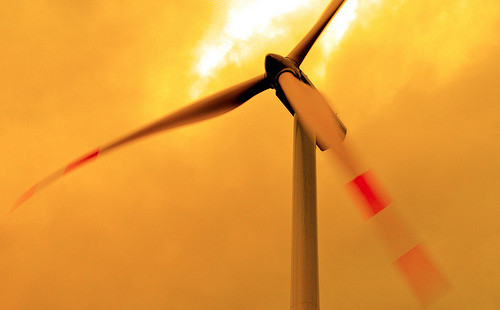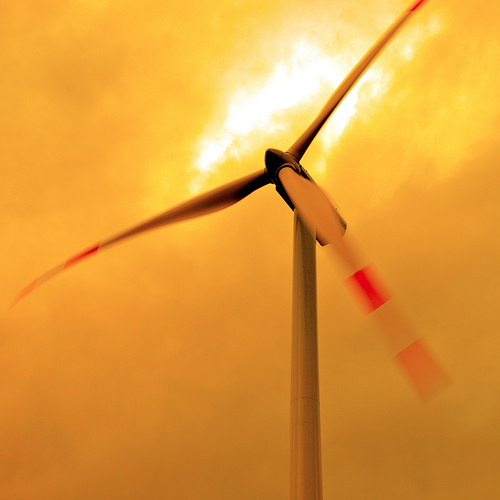
About Wind Energy / Why Wind Energy
You’ve probably noticed that wind is super abundant on our planet (funny video on this topic). Some report that wind in windy locations on or near land can power the world 6 to 15 times over. It is also the least-expensive energy source in many or even most regions now, and this is without taking important health costs of coal and natural gas into account.
In this wind energy guide, you will find a lot more information one wind, broken down into these 6 categories (with each on its own page):
- Introduction to Wind (this page)
- Installed Wind Power Capacity (organized by country, by GDP, per capita, and more)
- Offshore Wind Power Capacity & Projected Growth
- Projected Wind Power Growth Worldwide & in Leading Countries
- Cost of Wind Power
- Why Wind Intermittency is Not a Big Deal
We want this source to be as accurate and up-to-date as possible. You can help make it so by posting better/more current data in the comments below.
Intro to Wind
While we’ve been harvesting energy from wind for several decades, it is only in the last few years — as the world has become more concerned about global climate change — that we’ve increased installation of wind turbines to the point where wind has become a noticeable contributor to our energy mix. In 2010, installed wind capacity reached 197 gigawatts (GW) and produced about 2.5% of the world’s electricity.
Also in 2010, China surpassed the US in the total amount of installed wind capacity to grab the number one ranking. But number one is perhaps not as impressive when one takes into account the population size and GDP of China (as well as the US). More impressive, when one accounts for country size, are: Denmark, which gets 28.1% of its power from wind (compared to China’s 1-2% and the US’ 3-4%). For more along these lines, much more annual and individual country wind installation information can be found on page 2.
Wind is on the cusp of becoming a major source of electricity around the world. Wind is widely available around the world (see the map above from Global Energy Network Institute, click to enlarge) and its recent rapid growth is expected to continue, since it is already the cheapest or one of the cheapest sources for new electricity all around the world and its costs are projected to keep falling.
Community Etiquette:
We want this and following clean energy guides to be the most up-to-date, the most accurate, and the most comprehensive source of all things ‘new grid’ around. And we want your help making them so. So, please chime in if you’ve got updated or additional information to share. And, of course, please follow these basic community etiquette guidelines:
1) Don’t be rude in discussions with others.
2) If you want to comment, please look to see if someone has already started a thread that would be appropriate for your input. Post your comment there. It will make things much easier for whomever does the rewrite.
More On Wind:
On the following pages, we have sections on:
- Installed Wind Power Capacity (total and new in 2010; for the world as a whole and top countries; wind power per GDP; and wind power per capita)
- Offshore Wind Power
- Projected Wind Power Growth
- Cost of Wind Power
- Why Wind Intermittency is Not a Big Deal
Upcoming sections will include:
- Electricity Storage & Transmission
- Effects of Wind Turbines (on animals, humans, and the environment)
- More?
























Pingback: Clean Energy = More Jobs | CleanTechnica
Pingback: 54% of Spain’s electricity generation in April from renewables |
Pingback: Fifty-Four Per Cent of Spain’s Electricity Generation in April From Renewables
Pingback: Solar--Wind Hybrid Power Plants Approximately Twice As Efficient | CleanTechnica
Pingback: Largest Wind Farm In Southern Hemisphere Opens Down Under | CleanTechnica
Pingback: Solar = 100% Of New Power Capacity In March, Renewables = 82% In Q1 | CleanTechnica
Pingback: New York’s Potential Renewable Energy Future Mapped Out By New Study | PlanetSave
Pingback: 5 Home Technologies For Cleaner Energy | PlanetSave
Pingback: What’s 1 Megawatt Of Wind Energy? (Infographic) | PlanetSave
Pingback: Secret Group Pumping Hundreds Of Millions Of Dollars Into Anti-Wind, Anti-Solar, & Anti-Climate Action Campaigns | PlanetSave
Pingback: Solar & Wind Energy Overview −Solar Love!
Pingback: Marcacci Communications
Pingback: Businesses Increasingly Using Renewable Energy Options to Cut Costs - CleanTechnica
Pingback: The True Cost of Electricity Calculated - CleanTechnica
Pingback: Maryland’s Clean Energy Economy: Innovation Powered by Progressive Policy - CleanTechnica
Pingback: UK-Ireland Energy Cable Opens to Bolster Wind Power
Pingback: Greenpeace Energy Turns Wind Power in to Gas Power - CleanTechnica
Pingback: American Jobs at Risk (Approximately 40,000 of Them) - CleanTechnica
Pingback: UK’s Renewable Energy Capacity to Match Thermal Power Capacity by 2025 - CleanTechnica
Pingback: US Air Force vet converts silos to low-cost wind turbines : Renew Economy
Pingback: Air Force Vet Develops Low Cost Wind Turbine for Small Farms
Pingback: Donald Trump Trashes Wind Power in Palm Springs
Pingback: China Spearheads Approves 2,000 MW of Wind Energy Projects Worth $2.5 Billion in Hami Province | Planetsave
Pingback: Starbucks Bucks Mitt Romney on Wind Power
Pingback: Global Consumers Want More Renewable Energy - CleanTechnica
Pingback: Incentives for Writers for Building the Network
Pingback: New Gamesa Wind Order Heading to China
Pingback: 332-MW Wind Project for Germany (Part of a 996-MW Offshore Wind Farm) - CleanTechnica
Pingback: GE Celebrates 300 Wind Turbines Installed Brazilian Milestone
Pingback: Wind Power: Pros and Cons
Pingback: Vestas Receives New Italian Wind Order - CleanTechnica
Pingback: Walmart reveals First Industrial Wind On-Site Wind Turbine Project
Pingback: GE, Enel Green Power To Build Minnesota Wind Farm
Pingback: Ireland Orders 24MW Wind Power Deal From Vestas - CleanTechnica
Pingback: National Clean Energy Summit 5.0 - CleanTechnica
Pingback: Quebec Set To Add Another 700MW of Wind Energy - CleanTechnica
Pingback: Gamesa Finishes 74MW Wind Project in Mexico - CleanTechnica
Pingback: Trina Solar Expands into Canada with OEM Partnership - CleanTechnica
Pingback: Vestas Wins New Belgium Offshore Wind Order
Pingback: Easy Way to Support More Wind Energy (Plant Wind Power with a Click) - CleanTechnica
Pingback: Plant More Wind Power with GreenerGreenGrass (Click it for Good!) | Planetsave
Pingback: BC Wind Energy Costs Declining, Productivity Increasing: Report - CleanTechnica
Pingback: Carbon Omission | Planetsave
Pingback: Wind Power Compared to Electricity Production: Top Countries (CleanTechnica Exclusive)
Pingback: Top Wind Power Countries Per Capita (CleanTechnica Exclusive) - CleanTechnica
Pingback: Manitoba Announces Renewable Energy Jobs Fund - CleanTechnica
Pingback: Vestas Hits 50 GW Milestone (Over 46,000 Wind Turbines Installed Worldwide) - CleanTechnica
Pingback: Turbine Cowboys is “Cliffhanger” of Reality TV Entertainment - CleanTechnica
Pingback: Huge Scotland Wind Farm Given Green Light (on Shetland Islands) | Planetsave
Pingback: 5 US States Now Top 10% Electricity from Wind Power | Planetsave
Pingback: Trash to Treasure — Waste-to-Energy a Growing Industry - CleanTechnica
Pingback: Major League Baseball Leads Off 2012 With Clean Tech Investments
Pingback: Cape Wind Would Reduce Price of Electricity by $7.2 Billion, Study Finds - CleanTechnica
Pingback: Great Lakes states sign MOU to develop more offshore wind power
Pingback: Live Wind Energy Map Looks Like Living Van Gogh Painting (One of the Coolest Maps Ever) - CleanTechnica
Pingback: 6 Things You Really Need to Know about Renewable Energy
Pingback: Solar PV Reducing Price of Electricity in Germany | CleanTechnica
Pingback: New Mexican Community College Offers New Opportunity With Wind Program | CleanTechnica
Pingback: Water Power: Out with the New, In with the Old | CleanTechnica
Pingback: Cornell Getting Super Clean Energy NYC Campus
Pingback: UK Solar Schools Program Hits 1st Milestone 3 Months Early
Pingback: Float Your Wind Turbines To Save and Increase Production
Pingback: 5 States with Most Solar & Wind Energy Had Smallest increase in Electricity Prices 2005-2010
Pingback: Kenya Looking for a Geothermal Boom
Pingback: What if China Stimulated Domestic Demand for Solar Photovoltaic Power?
Pingback: Wind Energy Research to Maximise Power Generation
Pingback: Help Wind Energy - Get the PTC Renewed
Pingback: Massive Battery System Captures The Wind | CleanTechnica
Pingback: Increase Wind Power with Your Mouse | Sustainablog
Pingback: Fat Tax — What Do You Think?
Pingback: Take Action: Tell Congress to Continue Critical Clean Energy Policies | CleanTechnica
Pingback: World’s Largest Wind Power Project Moving Forward | CleanTechnica
Pingback: Wind Energy & Wind Turbine Market Booming Globally (1,750,000 MW Projected by 2030) | CleanTechnica
Pingback: Gopher State Becoming A Clean Tech Diamond In The Rough | CleanTechnica
Pingback: 3 Ways to Go Solar | Sustainablog
Pingback: $12.7 Billion for Transmission in Europe (Boon for Wind & Solar Energy) | CleanTechnica
Pingback: Three Israeli Innovations That Could Power U.S. Renewables | CleanTechnica
Pingback: Airborne Wind Turbines Win Award | CleanTechnica
Pingback: Texas Wind Power to Double by 2013 | CleanTechnica
Pingback: Wholesale Price of Electricity Drops to $0.00 in Texas, Due to Wind Energy | CleanTechnica
Pingback: Big Wind Farms Cost More Than Small Ones | CleanTechnica
Pingback: Wind Power Record Set in texas | CleanTechnica
Pingback: Peanut Butter Prices Rising Due to Climate Change
Pingback: Chance to Win Vespa! (from Wind Power Innovator) | Planetsave
Pingback: Food — Not for Everyone | Planetsave
Pingback: British Columbians Supportive of Wind Energy as Industry Aims for 2025 Goals | CleanTechnica
Pingback: Arista Power Introduces Portable Micro Wind Turbine | CleanTechnica
Pingback: Wind Energy Webinar — Interesting Information & Graphs | CleanTechnica
Pingback: Canadian Wind Power Capacity On Track For Record 2011 | CleanTechnica
Pingback: World Energy Report (Infographic) | CleanTechnica
Pingback: Eos Rechargable Zinc-Air Battery: Energy Storage “El Dorado?” | CleanTechnica
Pingback: How Obama Could Get His Job Groove Back | ecopolitology
Pingback: 24 Governors Ask Obama to Focus on Wind Energy Deployment | CleanTechnica
Pingback: Bringing Wind Power Down To Earth | Ecopreneurist
Pingback: Solar Power Intro & 3 Key Solar Power Points (+ Top Solar Power News) | CleanTechnica
Pingback: New Wind Turbines 300X More Powerful than in 1996 (+ Top Wind Power Stories) | CleanTechnica
Pingback: Plastic World (Infographic) – Green Living Ideas
Pingback: Plastic in Our Oceans, & How to Keep it Out {Infographic} – Blue Living Ideas
Pingback: Captain Planet, He’s our Hero! | CleanTechnica
Pingback: 10 Wind Energy News Stories {Weekly Round-Up} | CleanTechnica: Cleantech innovation news and views
Pingback: True Value of Solar Power – CleanTechnica: Cleantech innovation news and views
Pingback: Vertical-Axis Wind Turbines — An Option for You? – CleanTechnica: Cleantech innovation news and views
Pingback: Wind Power Subsidies Don’t Compare to Fossil Fuel & Nuclear Subsidies – CleanTechnica: Cleantech innovation news and views
Pingback: Why Wind Intermittency is NOT a Big Deal – CleanTechnica: Cleantech innovation news and views
Pingback: China Wind Power Blowing Up in 2011 (as Expected) – CleanTechnica: Cleantech innovation news and views
Pingback: {One of the Best Videos on the Web} Darth Vader Kid & Rep. Ed Markey on Clean Energy & Oil – Planetsave.com: climate change and environmental news
Pingback: 3 Key Wind Power Challenges & A Call to Action – CleanTechnica: Cleantech innovation news and views
Pingback: Renewable Energy in Germany Going to Get a Boost from Wind Energy Superhighway – CleanTechnica: Cleantech innovation news and views
Pingback: U.S. Wind Power Increasingly American-made (Creating U.S. Manufacturing Jobs) – CleanTechnica: Cleantech innovation news and views
Pingback: Germany Making It Easier to Build Offshore Wind Farms – CleanTechnica: Cleantech innovation news and views
Pingback: Wind Power is Making Electricity Cheaper (Exxon: Wind to be Cheapest Source of Electricity) – CleanTechnica: Cleantech innovation news and views
Pingback: World’s Largest Offshore Wind Turbine to be Constructed in North Sea – CleanTechnica: Cleantech innovation news and views
Pingback: Projected Wind Power Growth (Worldwide) – CleanTechnica: Cleantech innovation news and views
Pingback: Installed Wind Power Capacity per Capita (Country Comparisons) – CleanTechnica: Cleantech innovation news and views